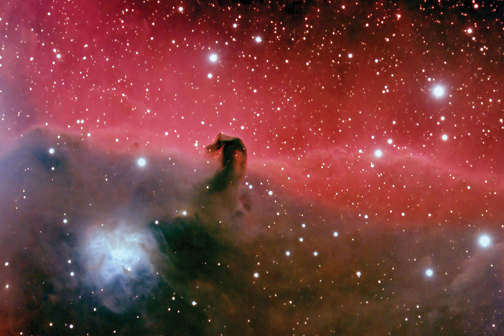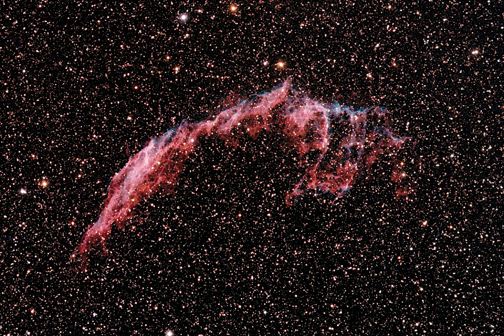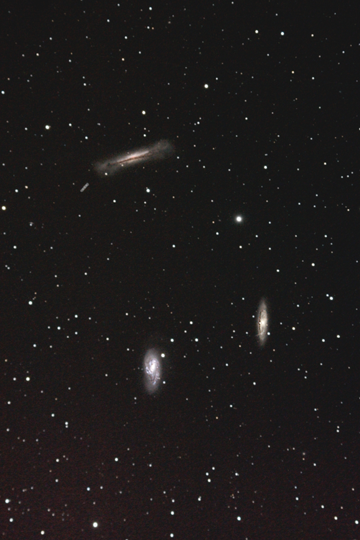Here are a few of the beautiful images Eddie Pavlu has captured during the decade of amateur astrophotography he describes in Reaching for the Stars from the Lens of a Telescope. The common fascination between things electrical and things astronomical is undeniable for so many of us that we are sure you will look forward, as we do, to the second part of Eddie’s article which details the creation of a home observatory and the techniques that allowed him to create these images.
The Horsehead Nebula
The Horsehead Nebula region is located in the constellation Orion, is approximately 1,600 light-years away, and spans about 5 light-years. A nebula can make itself visible by glowing as “emission nebula”; that is, by scattering light from stars within it as “reflection nebulae” or by blocking light from things behind it as “dark nebula”.
There are several objects in this image. The dark nebula that forms the Horsehead itself is known as Barnard 33. The horse-head feature is dark because it is an opaque dust cloud which lies in front of the bright red emission nebula. The red background is the emission nebula IC 434. The emission nebula’s red color is caused by electrons recombining with protons to form hydrogen atoms. The blue nebula just below and to the left of the Horsehead is the reflection nebula NGC 2023. The reflection nebula’s blue color is caused by blue star light that is reflected off the nebula. After several hundred thousands of years, the internal motions of the nebula will alter its appearance and will most likely no longer resemble a horse-head. I created this image by stacking 92 images of 5- and 10-minute exposures taken over 3 nights. The total exposure time is 690 minutes.

The Helix Nebula
The Helix Nebula is an example of a planetary nebula created at the end of the life of a Sun-like star and is occasionally referred to as “The Eye of God”. A nebula is a cloud of gas and/or dust in interstellar space. A planetary nebula is when the outer gasses of a Sun-like star are expelled into space. The remnant central stellar core, destined to become a white dwarf star, glows in light so energetic it causes the previously expelled gas to glow. The Helix Nebula, given a technical designation of NGC 7293, lies approximately 450 light-years away and spans about 1.5 light-years. I created this image by stacking 42 images of 5-, 10-, 15-, and 20-minute exposures taken over 4 nights. The total exposure time is 415 minutes.

The Eastern Veil Nebula
The Eastern Veil Nebula, designated NGC6992 and sometimes called the Bridal Veil Nebula, is located in the constellation Cygnus, is approximately 1,400 light-years away, and spans about 30 light-years. This nebula is the remnant of a supernova explosion that occurred about 10,000 years ago. A supernova is an explosion caused when a massive star, at least 8 times the Sun’s mass, dies and collapses. The outer layers of the exploding star are blasted out in a cloud. This expanding cloud, visible long after the initial explosion fades from view, forms a supernova remnant. I created this image by stacking 12 images of 10- and 20-minute exposures. The total exposure time is 151 minutes.

The Andromeda Galaxy
The Andromeda Galaxy, designated M31, is approximately 2.9 million light-years away. The light from Andromeda is created by the hundreds of billions of stars that compose it. The Andromeda Galaxy is our nearest large neighbor galaxy. Andromeda is about twice as big as the Milky Way, our home galaxy. While most galaxies are rushing away as the universe expands, Andromeda is the only big spiral galaxy moving towards the Milky Way. The best explanation is that the two galaxies are in fact a bound pair in orbit around one another and are falling back together. One very plausible scenario puts them on a collision course in about 3 billion years. I created this image by stacking 6 images that range from 2- to 15-minute exposures. The total exposure time is 47 minutes.

The Leo Trio Galaxies
This small group of galaxies consists of the Messier objects M65 (NGC 3623), lower right, and M66 (NGC 3627), lower left, along with the edge-on spiral galaxy NGC 3628, upper left. These three galaxies form a rather attractive triplet in the Leo Constellation and are referred to as the Leo Trio Galaxies. These galaxies are about 35 million light-years away. I created this image by stacking 14 images of 5 and 10-minute exposures. The total exposure time is 110 minutes.

For more from Eddie Pavlu…
Reaching for the Stars from the Lens of a Telescope
Shooting for the Stars with a DIY Observatory
 |
Eddie Pavlu was most recently Vice President of Operations at National Technical Systems. Prior to that he was President and CEO of Elliott Laboratories. He has a Bachelors and Masters degree in Electrical Engineering, and has been in executive management for the past 16 years. He is a senior member of the IEEE and a member of the EMC Society. Outside of business, he is an amateur astronomer and astrophotographer, with photographs published in several publications, including Astronomy Magazine. |
